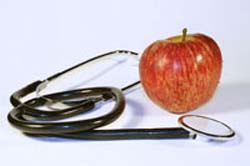 Folk wisdom has always singled out fruits and vegetables as being indispensable for health, but it has only been within the last thirty years that we know why.
Folk wisdom has always singled out fruits and vegetables as being indispensable for health, but it has only been within the last thirty years that we know why.
Science and technology have isolated compounds in plants and vegetables that have literally been our lifesavers. These are phytonutrients, which all fruits and vegetables produce because their means of survival in the environment is through the release of disease-fighting phytochemicals.
Phytochemicals stimulate the production of protective self-repairing cells in plants. They also produce the same kinds of responses in humans. For example, they release protective enzymes that inhibit cancer-producing substances, thus reducing our susceptibility to disease. It makes sense for us to harness the powers of plants in our diets. Sources of phytonutrients that cannot be ignored if we want to remain healthy and cancer free are berries, cruciferous and dark, leafy vegetables and red wine.
Berries, such as blueberries, cranberries, strawberries, blackberries, raspberries offer the highest sources of phytonutrients. They all produce a natural substance called ellagic acid that has been shown to be a good defense against carcinogens because they suppress tumor development. Blueberries have the highest antioxidant content. High in flavonoids, they are also believed to provide powerful protection against prostate cancer.
Two and a half cups of fresh strawberries a day can supply enough vitamin C to help restore sperm production in men. Cranberries have been known to prevent cystisis, a painful and often recurring urinary tract infection in women. A study involving 72 postmenopausal women found that 10 ounces of cranberry juice every day reduced the likelihood of bladder infection by 58 percent. Cranberries have also been shown to reduce stomach ulcers and lower LDL cholesterol levels.
Cruciferous vegetables, such as broccoli, Brussels sprout, cauliflower and dark leafy vegetables (Swiss chard, spinach) also have high levels of antioxidant phytonutrients. In a study conducted by New York’s Strang-Cornell Cancer Research Laboratory, women who consumed a diet high in cruciferous vegetables experienced a dramatic drop in estrogen levels, which means that these vegetables may be powerful tools for fighting against breast cancer.
The assumption is that the phytochemicals in these vegetables deactivate potent estrogens, thus preventing estrogen-sensitive cells, particularly in the breast, from developing tumors. Sulforaphane, another phytochemical in cruciferous vegetables, triggers a self-defense system in the body that acts to detoxify carcinogens. Spinach contains four times more beta-carotene than broccoli and is a good source of vitamins C and E. It also has high levels of photosynthetic proteins that convert sunlight into energy. Researchers at the Massachusetts Institute of Technology are harnessing the power of spinach in a new direction — creating highly cost-effective solar panels.
And last but not least is the phytonutrient, resveratrol, found in red wine, which literally makes wine drinking a cancer-fighting measure. Resveratrol is present in the leaves, twigs and bark of the grape vines. And red wine, which is fermented from grape skins, seeds and twigs, tends to have large quantities of these cancer-fighting substances. Resveratrol has also been demonstrated to be a potent antioxidant (more potent than vitamin C alone), which can act synergistically with vitamin C, thus enhancing the effects of each. It also prevents the formation of blood clots and promotes the formation of new dendrites in the brain.
Let us put all these phytonutrients to good use. Include with dinner your broccoli spears and cauliflower salad, warm berry compote and a glass of red wine … Yummy! Life cannot be better!
Mary Desaulniers has been running for 27 years, is a retired schoolteacher and writer; she says she is helping people “reclaim their bodies.” You can visit her at www.greatbodyat50.com or at www.greatbodyproteinpower.com
